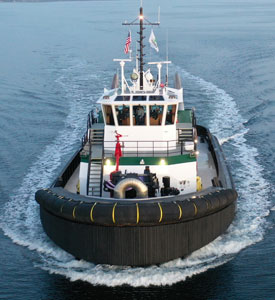Foss Maritime Company has updated the venerable Valor-class azimuthing stern drive (ASD) tugboat for a new era.
Foss, a Saltchuk subsidiary based in Seattle, took delivery of the 100-by-40-foot Jamie Ann this spring from Nichols Brothers Boat Builders. Jensen Maritime Consultants and Foss partnered on upgrades to the existing design that include new safety features and crew amenities. The MTU Tier 4 engines are the first for any U.S. tugboat.
Jamie Ann, named for Saltchuk co-founder Fred Goldberg’s daughter, will work in Los Angeles-Long Beach, Calif., escorting and assisting containerships and tankers. It is also equipped with large fuel tanks and a sturdy towing winch to handle rescue tows far from shore. Bollard pull is 92.36 tons off the stern and 90 tons off the bow.
“It’s a good, solid, 90-ton harbor boat,” John Parrott, Foss’s former president and COO, said in an interview late last year. “It’s well built and should last us 20 to 25 years using a design that is tried and true.”
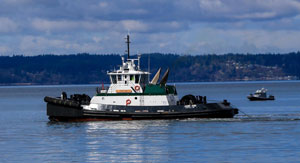 |
|
The 6,866-hp tug is the lead boat in what Foss calls its ASD-90 series. |
|
Foss Maritime |
Foss has one of the more capable harbor tugboat fleets on the West Coast. Its sleek 8,000-hp Garth Foss and Lindsey Foss deliver nearly 88 tons of bollard pull, and the 113-foot, 6,772-hp Caden Foss can pull 90 tons. Ever-larger ships regularly calling the West Coast have increased demand for high-powered tugs for escort and docking.
“Our customers,” Parrott said, “want us to have more 90-ton tugboats available in our fleet.”
Nichols Brothers, based in Freeland, Wash., has built 11 Valor-class tugs over the past 14 years. Baydelta Maritime of San Francisco ordered the original Valor, completed in 2006 and chartered by Crowley along with sister tug Vigilant. Last spring, Baydelta took delivery of Delta Teresa, the first diesel-electric hybrid in the class, now working in Los Angeles-Long Beach.
Valor-class tugs are known for high horsepower, impressive bollard pull ratings and assertive skegs for effective escorts. They have comfortable crew spaces and an enormous engine room. Foss built on these characteristics for Jamie Ann, the lead boat in the new ASD-90 class, and upgraded the design by increasing the fuel tank capacity for long voyages and rescue towing well offshore.
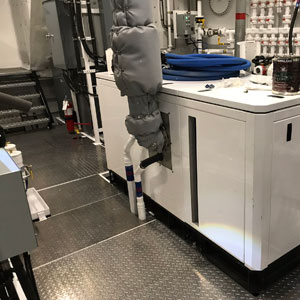 |
|
MER Equipment built a custom enclosure for its 65-kW Bollard harbor genset that sharply reduces noise. |
|
Foss Maritime |
“The design has been proven. That is for sure,” said Janic Trepanier, Foss’ project manager for the series of ASD-90 vessels.
The biggest difference between Jamie Ann and its predecessors can be found in the engine room. Foss replaced the Caterpillar 3516-series engines that powered all 10 previous vessels with twin 3,433-hp MTU Series 4000 Tier 4 mains. Those mains are paired with Kongsberg/Rolls-Royce US 255 z-drives — a constant since the namesake vessel — through a Vulkan carbon-fiber shaft.
Multiple factors influenced the switch to MTU engines. Cost was one; another, Parrott explained, is the growing push among manufacturers to sell propulsion systems as a single package. Caterpillar, for instance, is keen to pair its engines and drives. The same was true with MTU and Rolls-Royce a few years back when Foss was equipping its new tugboats, he said. Kongsberg Maritime has since acquired the Rolls-Royce division that produced z-drives.
Three John Deere gensets, two generating 120 kW and a third harbor unit producing 65 kW, provide electrical power. All three are installed forward of the main engines. Hiller supplied the FM-200 fire suppression system in the engine room. Firefighting equipment consists of a 100-hp Flowserve fire pump and forward-mounted Stang 2.5-inch monitor that can dispense 900 gpm.
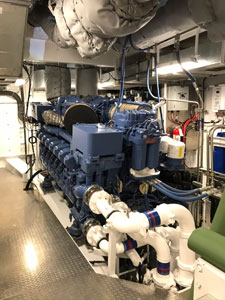 |
|
Jamie Ann’s MTU Series 4000 engines are the first on any U.S. tugboat that meet EPA Tier 4 emissions rules. |
|
Foss Maritime |
The MTU mains, like nearly all Tier 4 engines on the market, use a selective catalytic reduction (SCR) process to sharply reduce nitrogen oxides and particulate emissions. These units, installed above the engines in the ventilation spaces, required modest rejiggering of the machinery trunk, which in turn relocated a bathroom from the fiddley space to the lower accommodations.
Nichols Brothers developed a 3D model of the updated vessel design, allowing the entire vessel to be relofted before construction began. Trepanier said the 3D model provides better awareness of the vessel and a better sense for where the piping and machinery will go.
“The first one is always the hardest,” she said of the lead tug in the series. “The model made it a lot easier to build, and numbers two, three and four are going to be easier because we have a complete model after troubleshooting for the first one.”
There are numerous other changes to the original vessel design to improve efficiency, crew comfort and safety. Some examples include rescue doors built into the bulwarks, and extensive use of mineral insulation in the engine room to reduce noise in crew compartments.
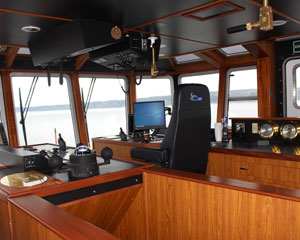 |
|
Jamie Ann’s finely appointed wheelhouse is equipped with Furuno navigation electronics. |
|
Nichols Brothers Boat Builders |
Foss encapsulated its 65-kW harbor generator inside a Bollard Sound Enclosure built by MER Equipment. Jamie Ann is the first tugboat with the Bollard enclosure, which was originally developed for the recreational market.
Each custom enclosure system is completely sealed from the engine compartment and uses the generator’s cooling fan to draw air into the unit. The exhaust leaves through insulated ducting after cooling the John Deere engine compartment, explained Robert Allen, CEO of MER Equipment, which supplied all three of Jamie Ann’s gensets.
“You can be in the engine room and talk to one another without shouting to be heard while the generator is running,” Allen said.
Jamie Ann can carry over 72,000 gallons of fuel, giving it ample capacity for offshore rescue tows off Southern California. For these, the tug is equipped with a double-drum Markey Machinery TESS-34AS towing winch installed on the aft deck. It is loaded with 2,600 feet of 2.25-inch wire in the port drum and 440 feet of 7-inch Samson AmSteel-Blue line in the starboard drum. The winch can be controlled from the wheelhouse, eliminating the need for crews to work on the aft deck.
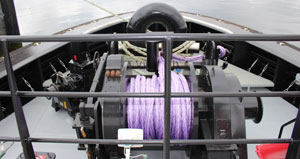 |
|
Markey Machinery supplied the hawser winch on the bow, above, and the towing winch, below, installed on the aft deck. |
|
Nichols Brothers Boat Builders |
A 75-hp Markey single-drum DEPGF-52R electric winch spooled with 525 feet of 9-inch Cortland Plasma line is installed at the bow, providing Jamie Ann and its sister vessels with the power necessary for handling some of the largest ships calling the West Coast.
“We worked very closely with Foss engineering and operations groups to define the specific winch performance and features needed for the Jamie Ann’s operations,” said Scott Kreis, Markey’s vice president of sales and engineering.
Jamie Ann’s interior spaces are similar to the preceding 10 vessels, albeit with the head moved down below and the forward void converted into a storage space. The main deck has the galley and mess, a full head and two staterooms; two other staterooms are located forward of the engine room. The vessel has accommodations for eight people but normally works with a four-person crew.
The wheelhouse is equipped in what has become the industry-standard layout that puts the helm chair between z-drive port and starboard controls. Foss chose radars and an AIS system from Furuno, Rose Point navigation software and a Simrad autopilot. Operators communicate using Icom radios and the Iridium satellite network, and can remotely monitor machinery spaces through closed-circuit TVs.
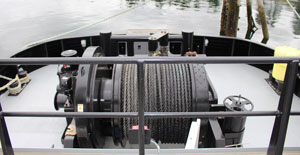 |
|
Nichols Brothers Boat Builders |
Jamie Ann Goldberg, a second-generation Saltchuk owner, formally christened her namesake tugboat on Feb. 29 — a few weeks before final delivery — on Whidbey Island. She described feeling a deep connection to the tugboat. “It is an honor to have this boat named after me,” she said in her address to the crowd of about 100 people attending the event.
The next three Foss tugboats in the series will be named Sarah Averick, Leisa Florence and Rachael Allen, all of whom are members of the Saltchuk shareholder family. Sisters Sarah Averick and Rachael Allen are daughters of Saltchuk co-founder Leonard Shapiro. Leisa Florence is married to Jamie Ann Goldberg’s brother, Paul Goldberg, a Saltchuk shareholder and board member.
Sarah Averick will be a sister tug to Jamie Ann, while the third and fourth tugs in the series will be outfitted for barge handling and equipped with smaller winches. Foss initially said the trio would join the fleet by 2021, although the precise schedule remains unclear given disruptions caused by the coronavirus outbreak.

